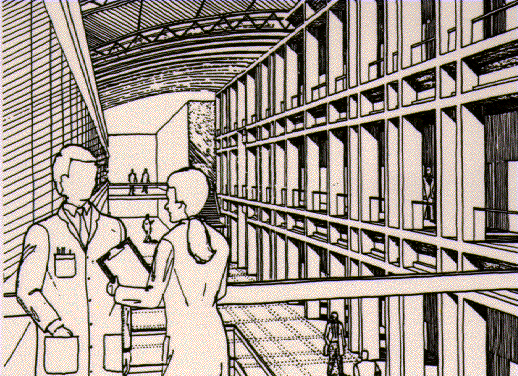



 |
|||
| Item | |||
| Building Site | Site building such that prevailing wind is to the rear side. Separate exhaust from intakes by more than 100 feet. Maximize separation between parking and air intakes. |
Minimizes entrainment of outside unconditioned air at main entrance. Minimizes reentrainment of laboratory exhausts at air intakes. Reduces potential for vehicular exhaust in building. |
|
| Location of parking garages | Relocate from under building to a separate parking structure away from the building. | Reduces potential for vehicle exhaust entering building. | |
| Location of air intake and laboratory exhaust stacks | Based on modelling and wind tunnel study -- increase exhaust stack heights and locate air intake vents based on prevailing winds. | Minimizes reentrainment of laboratory exhausts into air intakes. | |
| Radon | Specialized venting of the zone below the floor slab is unnecessary due to low radon levels from site-specific testing. | Requires appropriate HVAC air change schedule and loading pressurization. | |
| Delivery/loading zone | Maintain neutral pressure in area with supply and exhaust. | Eliminates entrainment of delivery vehicle exhaust. | |
| Landscaping | Select low-maintenance and nonsporulating plants. Use plants as a barrier for vehicle exhaust. |
Reduces intake of spores or fertilizer and other chemicals entering building. Potential for minimizing vehicle exhaust entrainment in building exits. |
|
| Laboratory exhaust hoods | Install flow gauges and alarms | Provides warning of air contaminants present in laboratory areas due to loss of air flow. | |
| Moisture accumulation | Install drain pans pitched toward drainpipe. | Reduces moisture in system that could result in bacteria contaminants introduced through HVAC system. | |
| Humidity control | No moisture carry-over into system. | Minimizes HVAC system moisture and resultant bacterial contaminants due to moisture. | |
| System maintenance | Provide access panels at all duct work appurtenances, and ample clearance around equipment. | Increases ease of maintaining HVAC system | |
| Outside ventilation rate | 100% outdoor air in laboratories; 20cfm/person in offices. Increase outside air ventilation rate 20% to accommodate unexpected sources. |
Maximizes removal of air contaminants and provides occupant comfort. Minimizes occupant exposure to contaminants. |
|
| Airflow efficiency | Fan-powered air terminal boxes rejected due to cost and high maintenance. | Not required since ADPI equal to or greater than 80% should be achievable. If more circulation is needed after balancing, fans can be retrofitted. |
|
| Air cleaning | Use ASHRAE 85% efficiency filters with some areas using HEPA filters. Provide filters on some laboratory exhausts. Design for ability to add air cleaning to laboratory exhaust ductwork. Bird-proof mesh screens. |
Minimizes dust and other aerosols from entering the indoor air via HVAC. Minimizes release of contaminants to ambient air. Eliminates bird droppings and resulting microorganisms from infecting HVAC |
|
| Thermal control | Central control system Fixed windows |
Occupants control temperature by calling system manager; less control by individual occupants. Optimum control of temperature and pressure. Eliminates unconditioned air entering the building. Maintains positive pressure in laboratories. |
|
| Exhaust system | 100% exhaust for photocopying rooms,laboratories, food preparation areas. Photocopiers located within 10 feet of exhaust vents |
Eliminates potential to recirculate air contaminants and odors throughout the building via HVAC system. Controls potential source of air contaminants; recirculated air is filtered prior to return to system |
|
| Smoking | Designate building as nonsmoking.Outside smoking areas will be situated away from building to avoid reentrainment. | Eliminates occupant exposure to environmental tobacco smoke hazards. | |
| Building materials,finishes, furnishings | Using existing furnishings to maximum extent. | Minimizes occupant exposure to contaminants as a result of building materials, finishes, and furnishings off gassing. | |
| Corrosion inhibitors | Inhibitors will not contain volatile amines. | Eliminates exposure to certain air contaminants. | |
| Carpooling/bikepaths | Designate priority parking spaces for carpools. Install showers to encourage biking, walking. | Reduces vehicular exhaust to ambient air and potential for reentrainment in building from parking facilities. | |
OARM-RTP/IRMD
Last Updated on